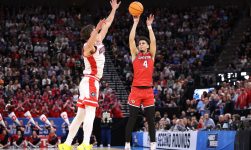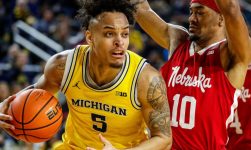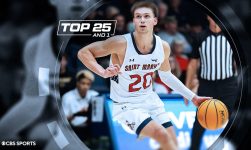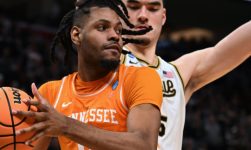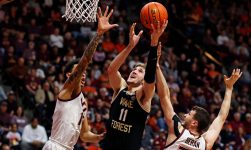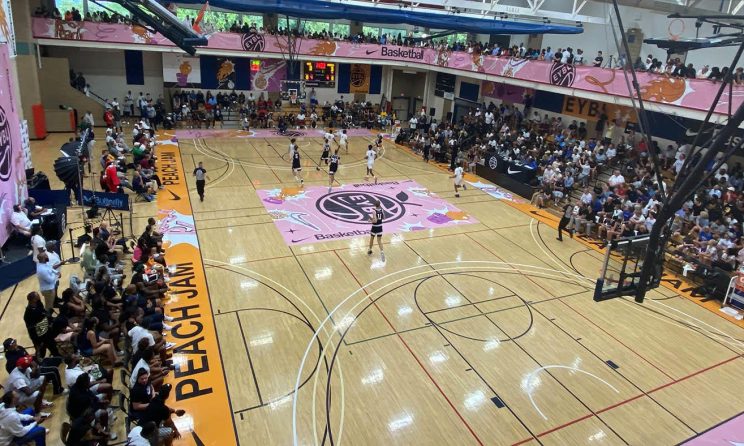
NORTH AUGUSTA, S.C. — Every year, the Nike Peach Jam gets bigger and brighter with its star power and big-tent presentation.
LeBron James, who’s attended a few Peach Jams in the past, has never been more prominent than he was the past few days here at the Riverview Park Activities Center. James took on the role of head coach, picking up the whiteboard and tutoring his son, Bryce, and their Strive For Greatness team. Beyond the spectacle of arguably the greatest player in NBA history strutting the sidelines in a South Carolina gym, the NBA (for the first time) invested in live streaming all week. It’s taken what was once a proud-but-niche recruiting event and morphed it into a buzzy, week-long celebration of high school basketball at its highest level.
NBA greats can be seen all over the facility. Carmelo Anthony’s been on hand to watch his son, Kiyan, play for Team Melo. Chris Paul, as he’s done for years, is back and coaching his CP3 program. Bradley Beal and Russell Westbrook are here. Rajon Rondo is LeBron’s assistant. It’s always awesome to see NBA legends giving back like this.
The best of the best in the 2024, 2025 and 2026 classes have also shined: Dylan Harper, the No. 1 player in the ’24 class, has reliably drawn crowds while playing for the New York Renaissance. The biggest non-LeBron draws, by far, are the two bigs in 2025: Cooper Flagg (Maine United) and Cameron Boozer (Nightrydas Elite). And on Friday, there was a must-see matchup between the top two players in 2026: A.J. Dybansta (Expressions Elite) vs. Tyran Stokes (Vegas Elite).
But beneath the glamour of the megawatt recruits, there’s a thrum of uncertainty and more than a dash of cynicism with a lot of high school recruiting — much of it tied to the realities of the transfer portal and how that has upended the calculus of program-building for power conferences and mid-majors alike.
“A lot of freshmen don’t want to be patient,” an SEC coach told CBS Sports. “Used to be that I’d come here looking for three or four high school players. Now it’s maybe one or two.”
College basketball recruiting is in the middle of a turbulent era. From a roster-building standpoint, it’s probably never been more volatile. There are two more seasons left with NCAA athletes getting a bonus year of eligibility due to COVID. That, in addition to NIL legislation and in addition to the transfer portal’s explosion, has made for an environment in the sport’s offseason that feels as fraught, unpredictable and taxing as it’s ever been.
There has long been a credo in college hoops: get old, stay old. It’s never felt more true than now, only instead of getting old by recruiting and retaining players for four or five years, teams are trying to get old by adding batches of transfers at rates never seen before. Coaches are prioritizing 21-, 22- and 23-year-olds (on their second or, sometimes, a third school) over the development of freshmen. To be clear, this is a two-way street. The coaches are adapting to the behavior of players, who are seeking the most playing time and/or money they can get in this nascent age of NIL.
“The thing is, they get the one-time transfer,” a Big Ten coach said. “If you can get a kid after he leaves, after his freshman or sophomore year, and then he’s stuck? That shit’s like gold, man.”
Added another Big Ten coach: “However many freshmen you take, you need to prepare to have that many spots available open in the spring. Freshmen are a bad investment. They’re all rentals.”
High school recruiting is the lifeblood of college basketball. Always has been, always will be. But the value of a non-five star player in 2023 seems to be less than what it was three years ago — let alone 10 or 20. The proof is in the visuals: Peach Jam aside, a lot of the live recruiting periods did not have nearly as many coaches showing up to watch players, at least not in the numbers that existed until the past two years.
“This spring, I would think half as many, half as much activity happened from a high school student standpoint as from two years ago,” Oklahoma State coach Mike Boynton said.
At some recruiting showcases, attendance plummeted.
“I was in Arizona, and I came back and said there may have been 100 less head coaches there, and the main reason is you had guys saying, ‘I’m home recruiting my own guys, and I’m also recruiting the portal,'” Kentucky coach John Calipari said. “They never left campus.”
At the high-major level, much less seems at stake in recruiting these days. Look no further than the rosters. Among high-majors, more teams than not have not/will not fill out all 13 scholarships. UCLA is at 10. North Carolina is at 11. Kentucky isn’t full. Neither are Kansas, Duke, Baylor, Texas, Indiana, Illinois, Georgetown and dozens more in power leagues.
“There is an element of continuity to a program which is hard to find right now,” Boynton said. “High school recruiting is probably still the most effective way to do that. But when you factor in how transient the industry is, in every respect, it’s hard to feel comfortable as a coach living in that space and certainly at the high-major level. It’s because high school kids, by and large, usually aren’t ready to help you win early. And now, they don’t stick around long enough to develop. So it’s a challenge, for sure.”
“There is an element of continuity to a program which is hard to find right now.”
Oklahoma State’s Mike Boynton
Recruits, outside of five-stars, aren’t being as prioritized as they once were. That has widespread effects that are felt broadly, even if they can’t be seen in the micro with each recruit. Ed Cooley, just three months into his new gig at Georgetown, hasn’t used all 13 scholarships in years and doesn’t believe he’ll ever do it again.
“I’m able to sell our future, given that it’s only one more year left of COVID players,” Cooley said. “So, college basketball is going to stay old, really old, for one more year. You have this year and then next year. … The value of the young high school kid right now is, for Georgetown, we can sell you on the future. I always say, ‘I’m going to help you fail early, so you’re really good in five-to-seven months.’ You can’t sell that to older kids. So, their value is their future with respect to where the future is going to take them. You couldn’t do that three years ago.”
In talking to a couple dozen coaches at the Peach Jam, there is a belief that, even if the value of a recruit has dipped for now, once the bonus COVID years are expired, it could rise again. The portal (in theory) might have 1,200 names a few years from now instead of nearly more than 1,800 (this year’s number). The COVID bonus year has also led to an untold number of Division I-level players who never got scholarships due to the trickle-down in this environment.
Calpiari said he’s gone to the NCAA multiple times and asked how many projected freshmen did not receive scholarships in the past few years. These are players who otherwise would’ve received them but were squeezed out due to the bonus COVID year afforded to all NCAA athletes. He believes it’s in the hundreds.
The real impact, and really how college basketball is obliquely impacted, comes with the four-star players. These are the guys who have long been the pillar-builders for schools, the type of players who rarely are one-and-dones and seldom are two-and-throughs. They grow into all-league players in the back half of their college careers. They still carry tremendous value as prospects (rare is a high-major coach who isn’t opting in on a top-100 player), but their futures are a lot murkier now with their value as freshmen taking a hit.
Because of that, a heavy dose of skepticism exists re: whether these four-star types will only play for one school. Coaches around the sport are banking on it not happening.
“If you can get some of the top 30-40 players, you do it, but you know, kids are transplants now,” Calipari said. “You’re going to bring a ‘program’ kid in? He may [no longer] be a ‘program’ guy.”
“There are kids who are going to school right now that plan on not being at that school a year from now, no matter what level of player they are,” Boynton said.
A weird duality has emerged in college basketball recruiting: Coaching staffs will sometimes spend two, even three years recruiting a player. If they’re lucky, they land that player. But that player’s impact on a program could easily wind up being inferior to a transfer who gets recruited for a week — sometimes a transfer decision takes a couple of days — who will transfer in and be better. That dynamic is why high school recruits hold less value now than ever.
“The freedom to be able to move not having to sit out with some transfer, it’s definitely opened up the floodgates for guys not having them don’t be as patient as they used to be,” Boynton said. “There’s definitely an element to being older and having to feel like you got a better chance to win, there’s no question about it.”
There are coaches who would still prefer to build almost entirely off of high school recruits, but it’s not easy. They are pushing against a current that has taken over the sport.
“I think it’s harder to bring a guy that it’s gonna take a long time to develop unless he comes from a family or a situation where you know they’re invested in the process,” San Diego State coach Brian Dutcher said. Dutcher is fresh off taking his team to the title game. The Aztecs were one of the most experienced teams in the country last season. “If you take a young kid that’s just talented and they want immediate success, then you have to really decide how important that is to you, because then they usually transfer. I’m so huge on high school because I just think your four-year guys are the ones that set the culture for your program.”
Even still, Dutcher, like most other coaches interviewed, admits to taking fewer high school recruits now than what was customary even three years ago.
“Last year, I signed two of the best freshmen I’ve ever signed — they couldn’t get on the floor,” Dutcher said. “But they’ll contribute in a big way this year.”
Up the road from SDSU, UCLA was the only power-conference program last season who had every roster spot filled by a non-transfer. Every player on the team began their career at UCLA. It won’t be that way next season, but Cronin’s portal opinions have been well-documented at this point.
“The people that are getting the best transfers are paying. And I’m not mad at them. It just is what it is,” he said. “We’ve all got to do things that fit our program. At Cincinnati, I had to get a certain type of kid that I could get there. Now, NIL and the way things are in the portal, there are certain kids that I can’t get. There are certain kids in the portal that are looking for money. So, it isn’t that Mick Cronin’s saying, ‘I don’t believe in the portal’ — I can’t get them.”
Used to be that choosing a college was a humongous step, a three- or four-year decision that paved the path to adulthood or a potential career playing professionally. For a lot of recruits, picking a college out of high school has morphed into a year-by-year pace. It’s reduced the value of recruiting in the spring and summer. It’s also reduced the value put on education.
“There’s a definite advantage to having guys that chose your culture,” Cronin said. “Then they help you build and maintain. To me, you have to have some of that. You can’t have all transfers.”
There’s a permeating thought that players ranked in the 25-100 range (low-end five-stars, all four-stars, high-end three-stars) are caught in the middle. Most are not old enough, strong enough, smart enough, skilled enough to be high-impact players at the power-conference level, especially not in this era of the bonus COVID year.
“Most kids [wanting to] come to Kentucky won’t accept that,” Calipari said.
These four-star players are too good to pass up as high school prospects, but probably not too good to upgrade your team in a meaningful way. So, instead, coaches’ focus on the portal in the spring has usurped priorities with a lot of these recruits.
“I think the idea of recruiting [in person] in April is pointless with the portal,” Cooley said.
College basketball recruiting remains a philosophy in flux, something altered excessively by the portal, and unless you’re great, you’re just another guy. At 18, 19 years old, you’re a rental. This is a business, and to hear it from those in the game, it’s never felt more baldly transactional than now.
“If you’re a kid who’s ranked 60th right now, you’re probably f—ed,” a high-major coach said.
There will invariably be dozens of players here at EYBL who go on to become really good college players. But they won’t be doing it in their first year, and for plenty of them, they probably won’t be doing it at their first school.
The spring and the tail end of the live period will wind up seeing fewer coaches invested, meaning fewer players ultimately get to Division I and have scholarships to play college basketball. Cooley, for example, won’t be going out to recruit in the final days of July. The NCAA-run academy, which went on hiatus in 2020, returns for the first time since 2019. A lot of coaches I spoke to at Peach Jam also said they had no plans on attending.
Here in North Augusta, though, fans are yet again filling the East Riverview Park Activities Center throughout the afternoons and evenings. The bleachers are packed with parents and supporters. Grassroots basketball is not only in a good place, it might be in the midst of its healthiest, most promising phase ever. But what’s good for the product isn’t always good for the player, and a lot of people in the sport are anxious to see if this is a passing phase or the permanent normal in the years to come.

